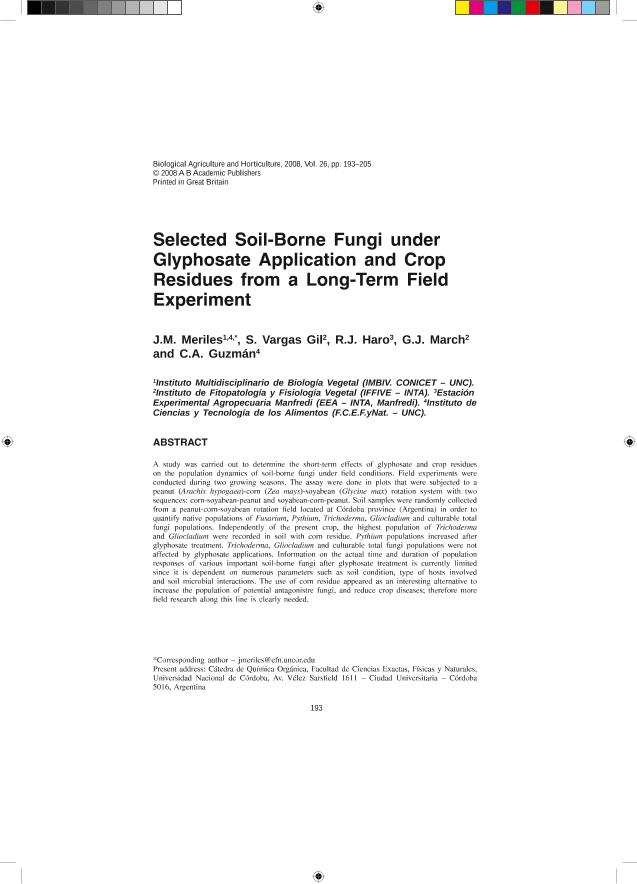Artículo
Selected soil-borne fungi under Glyphosate application and crop residues from a long-term field experiment
Meriles, Jose Manuel ; Vargas Gil, Silvina
; Vargas Gil, Silvina ; Haro Juarez, Ricardo Javier; March, J. G.; Guzman, Carlos Alberto
; Haro Juarez, Ricardo Javier; March, J. G.; Guzman, Carlos Alberto
 ; Vargas Gil, Silvina
; Vargas Gil, Silvina ; Haro Juarez, Ricardo Javier; March, J. G.; Guzman, Carlos Alberto
; Haro Juarez, Ricardo Javier; March, J. G.; Guzman, Carlos Alberto
Fecha de publicación:
03/2008
Editorial:
A B Academic Publisher
Revista:
Biological Agriculture & Horticulture
ISSN:
0144-8765
Idioma:
Inglés
Tipo de recurso:
Artículo publicado
Clasificación temática:
Resumen
A study was carried out to determine the short-term effects of glyphosate and crop residues on the population dynamics of soil-borne fungi under field conditions. Field experiments were conducted during two growing seasons. The assays were done in plots that were subjected to a peanut (Arachis hypogaea)-corn (Zea mays)-soyabean (Glycine max) rotation system with two sequences: corn-soyabean-peanut and soyabean-corn-peanut. Soil samples were randomly collected from a peanut-corn-soyabean rotation field located at Córdoba province (Argentina) in order to quantify native populations of Fusarium, Pythium, Trichoderma, Gliocladium and culturable total fungi populations. Independently of the present crop, the highest population of Trichoderma and Gliocladium were recorded in soil with corn residue. Pythium populations increased after glyphosate treatment. Trichoderma, Gliocladium and culturable total fungi populations were not affected by glyphosate applications. Information on the actual time and duration of population responses of various important soil-borne fungi after glyphosate treatment is currently limited since it is dependent on numerous parameters such as soil condition, type of hosts involved and soil microbial interactions. The use of corn residue appeared as an interesting alternative to increase the population of potential antagonistre fungi, and reduce crop diseases; therefore more field research along this line is clearly needed.
Palabras clave:
Glyphosate
,
Crop Residues
,
Soil Borne Fungi
,
Fusarium
Archivos asociados
Licencia
Identificadores
Colecciones
Articulos(IMBIV)
Articulos de INST.MULTIDISCIPL.DE BIOLOGIA VEGETAL (P)
Articulos de INST.MULTIDISCIPL.DE BIOLOGIA VEGETAL (P)
Citación
Meriles, Jose Manuel; Vargas Gil, Silvina; Haro Juarez, Ricardo Javier; March, J. G.; Guzman, Carlos Alberto; Selected soil-borne fungi under Glyphosate application and crop residues from a long-term field experiment; A B Academic Publisher; Biological Agriculture & Horticulture; 26; 2; 3-2008; 193-205
Compartir
Altmétricas



